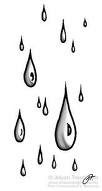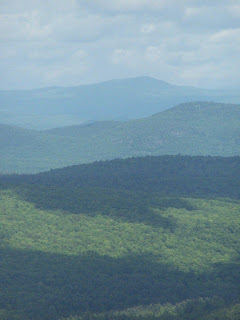Types of Rainfall
By Janine and Dave
As the right coast bakes in an historic June heat wave, we in the Pacific Northwest are grateful for the few sun breaks that punctuate gray days of rain. While we await the sunny summer that must be just around the corner, we thought a few facts about and some odes to rain would be timely.
Juniper Pluvius is the bringer of rain and as such he must be a God who is up close and personal with Oregonians.
One of our locals stated to Janine that you could tell an Oregonian because we know the words for at least 7 types of rain.
The 7 types were not disclosed as it was more like we have 7 times more rainy days than most every place else and we all know the words for them.
So Janine and I are working on naming the 7 types we supposedly all know and identifying how many others we can conjure up.
After all, we’ve heard that Eskimos have a zillion words for “snow” – except that is an urban legend.
http://en.wikipedia.org/wiki/Eskimo_words_for_snow .
Oh well.
But before we get there, we need to understand a little bit more about the science of rainfall. My first understanding of rain was, not surprisingly, a childhood saga:
Adventures of Randy the Raindrop
Anonymous
Randy the raindrop lived in a cloud.
The heat from the sun made him big, strong, and proud!
He got bigger and bigger until one day – Oh My!
He fell though the floor of his house in the sky!
Randy was scared, then he noticed more raindrops falling.
“Hey Randy, isn’t this fun?” they were calling.
Then onto a leaf with a splash Randy fell,
And what happened next is a strange thing to tell.
Randy was made up of water, you know,
a part of him went to help the tree grow.
The rest of him went into a puddle so round,
Then the sun came out and shone on the ground.
The sun warmed Randy and he started to change.
He became water vapor – My isn’t that strange?
Little drops of water, too tiny to see,
Floated into the sky – yes that was Randy!
Randy’s home once again was a cloud in the sky.
He was a raindrop once more, but then by and by…
The sun made him bigger and bigger and then…
He fell through the floor of his house once again!
And come back when you are finished. (The sound effect is pretty cool too.)
According to Wiki – “the five major types of precipitation are rain, snow, sleet, hail, and freezing rain. (Rarer forms include graupel (ice attached to snow, or "soft hail") and ground ice (also known as "ice needles" or "diamond dust"), which is ground-level condensation of ice crystals, with or without an associated fog cloud. Snow, because of its form, provides much less than its volume in liquid water when it melts.)” And, yes, we do have all of the above, as well. But that’s enough of the scientific stuff.
7 Kinds of Rain
So now we are ready for An Oregonian’s 7 Kinds of Rain (to be clear we are speaking of an Oregonian who lives in a temperate rainforest on the west sloop of Mt. Hood. Other Oregonians are welcome to share their comments with us also.)
Oregon Facial: That slight mist, coveted by Day Spas, that gently caresses face and body
Intermittent rain: Rain of any weight that is interspersed with rain free periods and, when Lady Luck smiles, sun breaks
Showers: Light rain, requiring jacket or windbreaker
Drizzle: medium weight water falling from perpetually gray sky
Rain: steady, medium weight drops
Downpour: Heavy drops and many of them
Torrential rains: Sky opens up and dumps so much water that you think the trees will drown and maybe you with them
So…all you creative webbed fingered and footed Oregonians, will you use the comment section and give us more?????
The Art of Rain Fall
We have covered the science of rain but how about art? To start us off, here is a link to Jackson Brown and Joan Baez singing Before the Deluge:
And what of poems beyond Randy the Raindrop?
Acquainted with the Night by Robert Frost
I have been one acquainted with the night.
I have walked out in rain - and back in rain.
I have outwalked the furthest city light.
I have looked down the saddest city lane.
I have passed by the watchman on his beat
And dropped my eyes, unwilling to explain.
I have stood still and stopped the sound of feet
When far away an interrupted cry
Came over houses from another street,
But not to call me back or say good-bye;
And further still at an unearthly height,
One luminary clock against the sky
Proclaimed the time was neither wrong nor right.
I have been one acquainted with the night.
Like Frost, many of us acquaint rain with the night. And though we can complain, those of us in and around Crutcher’s Bench have intimate knowledge of rain. We, like Tu Fu, know it as the bringer of life.
Morning Rain by Tu Fu
A slight rain comes, bathed in dawn light.
I hear it among treetop leaves before mist
Arrives. Soon it sprinkles the soil and,
Windblown, follows clouds away. Deepened
Colors grace thatch homes for a moment.
Flocks and herds of things wild glisten
Faintly. Then the scent of musk opens across
Half a mountain -- and lingers on past noon.
Photo: Rain on mountain foothills
If amount counts, we Crutcher’s Bench and Hoodland dwellers are experts in rain. Here we receive between 80 and 100” of rain each year. It’s how we get our rich green on. In comparison, Portland receives about 40” per year and Seattle 50”. The island of Hawaii, on the Hilo side, receives as much or more than we do. Does amount count when the sun warms the land to 80 degrees as soon as the rain stops?
While you await summer sunshine, send us your rain names, rain science or rain art.






